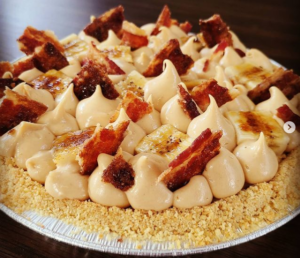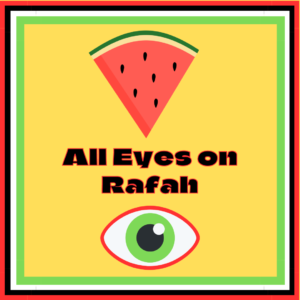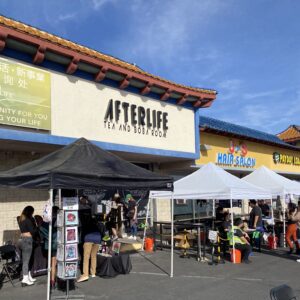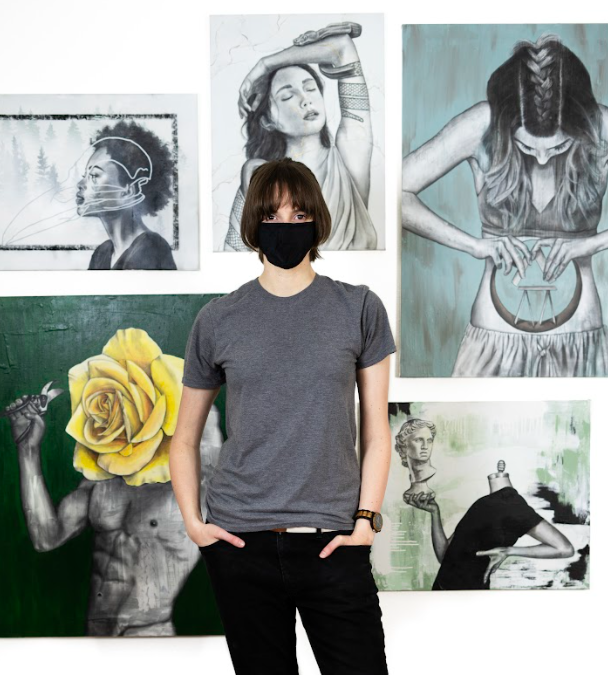
Fizzywood
Local mixed-media artist Elizabeth Woods, a.k.a. Fizzywood, uses surrealism to depict the difficulty of the human experience. Initially, art served as a hobby and a way for her to express herself and her emotions. Later, art also became her livelihood.
From a young age, Woods explored her creativity through art. Predominantly using colored pencils, her favorite subjects to draw were animals, particularly birds and whales.
“My father was a studio artist so I grew up in a very art-friendly household,” she said. “As I got older I kept art as a hobby I periodically returned to.”
While most of Woods’ drawing ability developed over years of practice, she credits her growth as an artist to other avenues of learning too.
“I took a drawing class in college that helped with my ability to think proportionately,” she said. “I still take online classes and watch tutorial videos, especially when I’m exploring a new medium. I’m working on an oil painting right now that I couldn’t have started without a lot of assistance from strangers on the internet.”
Nowadays, the subjects of her artwork now center around portraits of surrealism while exploring different art styles.
“I’ve worked in a wide array of mediums, but my favorite for a time has been charcoal,” she explained. “I usually start with an abstract background of latex and acrylic paint, to try to texturize the piece and give it some visual interest. Then I draw with charcoal over it.
Exploring Emotion Through Her Art
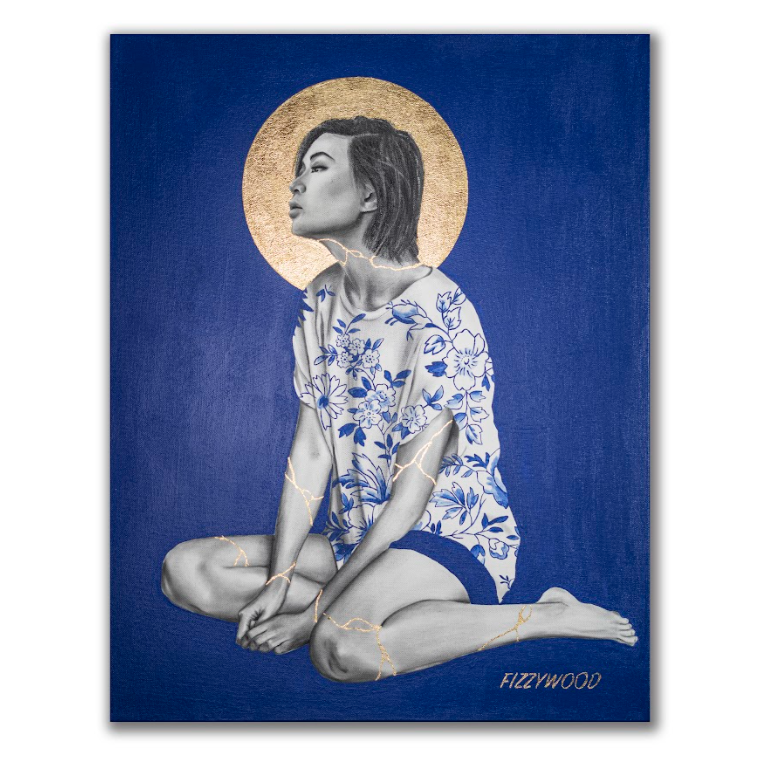
Charcoal, Gold Leaf, and Latex Paint on Canvas
When creating art, Woods pulls directly from her own experiences. From this, she works out her own negative thoughts and emotions, using them as inspiration.
“People laugh when I tell them it’s my depression [that inspires me] because it feeds into the Suffering Artist trope, but it’s true,” she said. “When I’m having a particularly difficult day, I take out my notes app and I try to write down what it feels like to be in that moment. Later, when I’m feeling better, I’ll make a sketch of it and hopefully, it’ll develop into a full piece.”
Woods then explained how the way she uses art is therapeutic to her.
“Because my themes are mostly negative emotions and experiences that are familiar to people, I meet people who have been through something similar,” she said. “By selecting a piece of art and telling me they connect with it, they are selecting a part of my own life and telling me that they see what I’ve been through and that they can empathize with it.”
In her experience, Fizzywood reports that the best feeling is when a person tells her that she’s captured an emotion so accurately that they understood the piece without needing an explanation.
Creating a Business Surrounding Her Art
The pandemic put Fizzywood in a situation where she felt inspired to explore new opportunities for her craft.
“During the pandemic, I was laid off from my job. This forced me to think more creatively when trying to make income,” she said. “Luckily, I had money saved away, which helped in the first few months, but the rest was work and sheer determination. I wanted to work for myself, and I’m proud to say I’m still doing so.”
While self-described as a “one-woman machine,” Woods credits her wife with helping her market herself and producing some of the digital aspects for her.
“At my core, I’m a very hands-on type of person. I’m lucky to have my wife, who I can goad into taking pictures of me for Instagram,” she said.
Prior to starting her art business, Woods conducted “fanatical research” about every artist she knew. She also explored what she believed would and wouldn’t work for her.
“I knew I wanted to focus on selling copies of paintings. There are a few that are near and dear to me that I don’t ever want to sell, so I started looking into the print market,” she said. “I have sheets and sheets of notes of local artists, famous artists, favorite artists, and their price points, markets, websites…. Anything you can possibly do research on, I researched it.”
Starting Out
Fizzywood attended Art Show LV(@artshowlv) for her first show, an event put on by local artist Gemjaxx.

“Because it only cost $15 to table at it, it felt like the best possible way to get my foot through the door,” she said. “It’s so strange to think about that dinky little table. I even had watercolor prints at the time, that’s how completely different it is now.”
Originally, Woods attended a lot of different events to sell her artwork. Now, the main event she vends for the majority of her in-person selling at is the First Friday festival. She conducts the rest of her dealings online.
“I used to do pop-up shops and events more often, but they seem to favor crafts over art. I’ve gone to events and sat in a tent without a single sale for the full day before. It can be frustrating and disheartening, so I don’t subject myself to it anymore,” she explained. “The best place to find me is at First Friday because it’s marketed for artists as well as craftsmen.”
The Art of Fizzywood
Woods now runs a successful art business that keeps her busy producing a wide range of products.
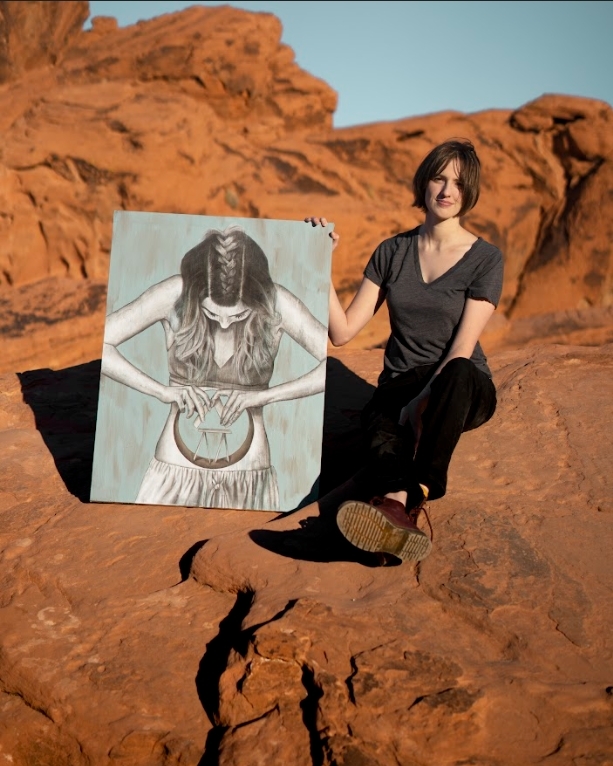
“I sell mostly prints, both on paper and canvas. Generally, I keep a stock of paper prints, but my canvas prints are made to order,” she said. “I also sell the odd original, and I’ve been testing some new products [like] stickers and magnets that I hope to premiere in the coming months.”
While many artists use a third-party service to produce their prints, Woods makes all her prints herself.
“I own a professional photo printer that can print my 12”x16” images,” she said. “In the days leading up to First Friday you can find me locked in my studio, printing, and packaging all of my stock by hand.”
On that note, Woods added that she plans a month in advance for each festival, and likes to find ways to change things up.
“Even though First Friday has an overarching theme, my booth also has its own theme that incorporates the time of year and whichever pieces I bring,” she explained. “March’s theme was ‘Tea Time in the Garden’”. I don’t think anyone actually notices that my booth changes or anything, but it makes it just that bit more whimsical to me.”
Woods also occasionally takes on commission work, though she shared she’s “wildly expensive” to hire.
“Commissions take time away from making art that I can sell prints of. Since I cannot sell prints of the commissions I take, I charge more upfront to balance the costs,” she said. “I would honestly suggest finding another artist for commission work, but I offer them because of demand.”
(Article continues after ad)
Check out our amazing sponsor!
Learning as She Goes
Since starting out, Woods shared what she wishes she knew then what she knows now.
“You’d think it would be this amazing sage wisdom about facing fears or something, but it’s probably something specific like “Don’t bother with the 16×20” mats” or “Don’t name any pieces after a zodiac sign unless you’re going to make all of the rest of the zodiac because people will assume you will, even if you tell them you won’t.”
She added that people want to support artists, they just need to connect to the right piece of art.
“Don’t be afraid to tell people about the inspiration behind the piece, or the process of making it,” she said.
How Mental Health and Art Coincides for Fizzywood
As previously mentioned, Woods’ inspiration for her art stems from her depression. Additionally, she shared that she can more accurately explain how she feels with a visual medium than she can vocally express.
“It’s easier for me to say “He took a piece of me with him” with art than to use hollowed out words and expressions,” she explained. “I have shown my art to my therapist and I’ve met a few therapists at art shows who now have my art in their offices. I think, even if you’re not the one creating the art, that it’s sometimes therapeutic to just point to an image and say “That is how I’m feeling right now.”
While her art relates to her mental health, Woods said that art does not help her with keeping her mind healthy. Rather, she finds that it helps as a tool to communicate her struggle with others and meet people who feel the same way. But, she added that it can only help so much.
“Art starts the conversation, but I rely on the expertise of professionals to help me work towards maintaining a truly healthier mindset,” she said. “Otherwise I’m a girl who paints sad pictures in her room, hoping for the sadness to eventually go away.”
In addition to her artwork, Woods also shared that she writes to explore other outlets of self-expression.
“I actually just finished writing a full-length novel that I’m pretty excited about,” she said. “I think that people who want to create will find a way to do so, even if it takes them far away from their area of comfort.
#GetinMotion with Fizzywood
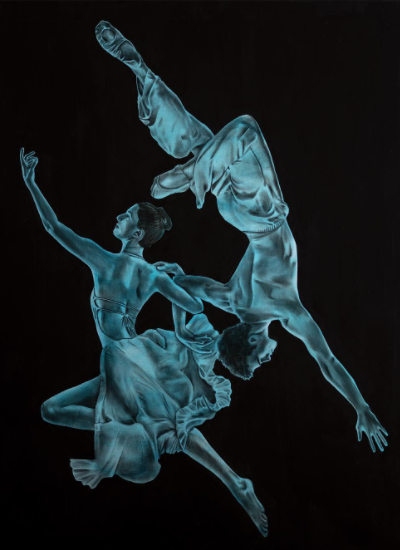
Latex and Acrylic Paint with Charcoal on Canvas
Woods shared that her current goal for her art is to work towards sustaining herself as a full-time artist.
“The Starving Artist trope is, unfortunately, not without a grain of truth. Art supplies are expensive and I’m trying to eat,” she said. Moreover, Woods wants to evolve her art business into being more self-sustaining. “Right now I’m trying to survive but, in the future, I’d like to thrive. I want to reach a place where I can sell online and not have to set up a tent in 120-degree weather.”
To best support Fizzywood, follow her on Instagram and check out the art available for purchase on her website. Her art is also available to purchase in person at the First Friday festivals she vends at.
Woods’ concluded by encouraging people to support local artists in general, especially at events like First Friday.

